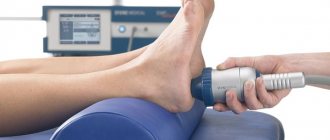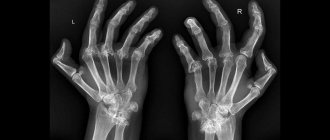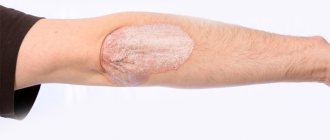Still's disease
Causes
Despite numerous studies, the exact causes of the disease have not yet been established. There are several theories about the appearance of pathology:
- infectious - it is assumed that the disease can develop as a reaction to the penetration of bacteria or viruses (rubella, parainfluenza, cytomegalovirus) into the body;
- genetic – about hereditary predisposition;
- immunological – classifies the disease as an autoimmune disorder.
But there is no data to fully confirm either of these theories.
Symptoms
The pathology is characterized by a variety of clinical manifestations. Among the many symptoms, the most common are:
- Fever – an increase in temperature to 39 degrees or higher. Unlike other infections, its high values do not persist constantly. Most often, fever occurs in the evening, sometimes twice a day. After a high rise, in most patients the temperature drops to normal levels.
- Skin rash - in the form of flat pink spots on the arms, legs, torso, and less often on the face. Appears periodically, usually at a temperature rise, then disappears. Due to its dull color, periodic disappearances, and absence of itching in most cases, the rash often goes unnoticed by patients. Sometimes the disease manifests itself with atypical skin symptoms: pinpoint hemorrhages, the appearance of painful nodes, hair loss.
- Joint syndrome - manifested by pain in muscles and joints (mainly during fever) and arthritis. The most typical lesions are the wrist and small joints of the hands. This sign allows you to differentiate the disease from lupus erythematosus and rheumatoid arthritis. Adults often develop ankylosis (immobility) of the wrist joints.
- Damage to the organs of the lymphatic system - characterized by simultaneous enlargement of the liver, spleen and inflammation of the lymph nodes. In half of the cases, the cervical lymph nodes become inflamed. With atypical symptoms, lymphadenitis is accompanied by necrotic phenomena.
- Sore throat - occurs at the beginning of the disease, resembles a sore throat.
- Cardiopulmonary symptoms manifest themselves in the form of serositis (inflammation of the serous membrane of these organs). In 20% of cases, aseptic pneumonitis develops, occurring with symptoms of pneumonia: cough, fever, shortness of breath. Sometimes the pathology is accompanied by cardiac tamponade, myocarditis, and acute respiratory failure.
- Eye symptoms – the disease is characterized by an ocular triad: uveitis, corneal dystrophy, cataracts. Their symptoms appear very early, even before signs of polyarthritis appear. They are often discovered by chance during medical examinations. In the absence of joint damage, eye symptoms develop relatively slowly.
In children, the disease occurs in the same way as in adults. But in childhood, symptoms are often subtle, making it difficult to make a diagnosis. Neglected cases can lead to disability for the child.
Diagnostic methods
The disease has no specific symptoms, and their absence makes diagnosis difficult. To exclude other pathologies, doctors need a certain amount of time to monitor the patient. A number of studies are also prescribed.
Diagnostics include:
- Clinical blood test - reveals severe leukositosis, an increase in ESR (erythrocyte sedimentation rate) up to 50 mm/h.
- Biochemical tests - determine increased levels of proteins, increased activity of liver enzymes.
- X-ray of joints - shows effusion in the joint cavity, swelling of soft tissues.
- Joint puncture – contents with signs of inflammation are obtained.
If necessary, patients undergo a biopsy of lymph nodes, X-ray of the lungs, ECG, ultrasound of the heart, and consultations with a cardiologist and pulmonologist are prescribed.
Therapy for Still's disease
The pathology is curable only in 30% of cases. Treatment of acute manifestations begins with NSAIDs (non-steroidal anti-inflammatory drugs). Their reception takes 1-3 months. For disorders of the heart and lungs, hormonal drugs (prednisolone, dexamethasone) are prescribed. If the disease develops in life-threatening forms, methylprednisolone or betamethasone is used for intra-articular administration. In chronic cases, methotrexate is recommended to control arthritis and chronic systemic processes. As a backup treatment for severely ill patients, clinical recommendations include cyclophosphamide, a drug with an immunosuppressive effect.
If conservative treatment for 6 months to 1 year does not bring results, the patient may be offered surgery to resect the synovium of the joint.
Still's disease is a fairly serious pathology that can lead to disability. But with proper treatment, most patients live full lives even years after diagnosis.
Sources
"Arthritis: Overview", UK National Health Service https://www.nhs.uk/conditions/arthritis/
"Adult Onset Still's Disease", US National Organization for Rare Disorders https://rarediseases.org/rare-diseases/adult-onset-stills-disease/
"What is adult-onset Still's disease (AOSD)?", National Rheumatoid Arthritis Society UK https://nras.org.uk/resource/what-is-adult-onset-stills-disease-aosd/
General information about the disease
The disease was first described by George Still in the 19th century. (it was named after him). Still's disease was long thought to be a type of chronic disease called juvenile rheumatoid arthritis, a condition that was thought to only affect children under 16 years of age.
Modern research confirms the possibility of developing this pathology in adult patients. Still's disease occurs very rarely in adults: from 0.16 to 1.5 cases per hundred thousand population. There are approximately the same number of cases among men and women. The maximum number of pathologies is observed in the age category from 16 to 25 years and from 35 to 45 years.
Treatment is provided by rheumatologists.
Still's disease affects joints and systemic organs
How is the treatment carried out?
The treatment method depends on the clinical picture. All efforts are aimed at stopping destructive processes.
Basic therapy
Basic therapy is based on the use of anti-inflammatory drugs, in particular Sulfasalazine.
NSAIDs and glucocorticosteroids
In the acute course of Still's syndrome, NSAIDs (non-steroidal anti-inflammatory drugs) are used, which help every fourth patient. Treatment can last 1-3 months.
Glucocorticoids (Prednisolone or Dexamethasone) are used to treat Still's disease in patients with disorders of the cardiac and respiratory systems.
Antimalarials and sulfonamides
For the treatment of Still's disease, the use of antimalarial and sulfonamide medications gives good results.
Cytostatics and biological drugs
In the chronic form, in order to reduce the proportion of hormones, they drink cytostatics. Usually they use Methotrexate, which is similar in composition to folic acid. Severe cases require taking Cyclophosphamide.
The method of treatment depends on the clinical picture
If conventional treatment does not produce results, then immunosuppressants or immunomodulators are prescribed.
Physiotherapy
To make treatment proceed faster, patients additionally undergo physical procedures: electrophoresis, magnetic therapy. During the period of remission, a course of massage and therapeutic exercises have a positive effect.
Prognosis for recovery
The disease may disappear spontaneously. Such recovery usually occurs in the 6-9th month from the onset of the pathology. If this does not happen, then the disease becomes chronic or takes on a recurring form.
The chronic course is accompanied by symptoms of polyarthritis: movements in diseased joints are severely limited.
Relapses cause single exacerbations, sometimes there are repeated cases.
For 90-95% of adult patients with Still's disease, the prognosis is favorable. Death is caused by secondary infections.
In childhood, more than half of patients recover, followed by complete remission.
Cytostatics and biological drugs
Cytostatic drugs include Methotrexate, Arava, Remicade, Equoral, Cyclophosphamide and many other drugs. Most often used in the treatment of juvenile rheumatoid arthritis:
- Methotrexate. “Gold standard” in the treatment of diseases of the musculoskeletal system. The required dosage is selected individually, but on average it is enough to take 1 tablet every 7 days. The effect of its use develops after 5-6 weeks from the start of use. The maximum concentration of the substance in the blood is reached after 6-12 months.
- Arava. Prescribed in case of side effects from taking Methotrexate. Begins to act in 4-6 weeks.
- Remicade. It has a faster therapeutic effect, but has a fairly large list of contraindications. It is used only in the absence of proper results from taking other basic drugs. Requires simultaneous administration of antihistamines, as it can provoke the development of an allergic reaction.
Biological drugs quickly and very effectively relieve inflammation. However, they also have some disadvantages. They can only be used in a hospital setting, since this group of drugs must be administered under the supervision of a physician. The duration of drug administration ranges from 30 minutes to 2 - 3 hours, depending on the chosen dosage. This group of medications includes:
- Etanercept. Provides an increase in the transport of leukocytes to the site of the inflammatory process, thereby enhancing the immune response.
- Anakinra. Has an inhibitory effect on Interleukin-1. As a result, the activation of inflammatory cells becomes impossible.
- Orence. It is the drug of choice in case of ineffectiveness of other basic drugs, in particular Methotrexate. Often used in the treatment of children.
- Actemra. Neutralizes Interleukin-6, which is one of the main mediators of inflammation. Used as monotherapy or combined with Methotrexate.
- Rituximab. Reduces the number of lymphocytes and prevents the progression of the inflammatory process.
Sources
- https://okeydoc.ru/bolezn-stilla-u-vzroslyx-iu-detej-simptomy-lechenie/
- https://www.neboleem.net/bolezn-stilla.php
- https://diartroz.ru/artrit/revmatoidnyy-artrit/bolezn-stilla-i-felti.html
- https://NogivNorme.ru/bolezni/artrit/vidy-artritov/bolezn-stilla.html
- https://medbe.ru/materials/klinicheskie-rekomendatsii/bolezn-stilla-u-vzroslykh/
- https://www.syl.ru/article/299139/bolezn-stilla-prichinyi-simptomyi-diagnostika-i-osobennosti-lecheniya
- https://lechenierebenka.ru/bolezn-stilla-u-detej/
- https://sustavy-lechenie.ru/bolezn-stilla-vzroslykh-detey-priznaki-simptomy-lechenie/
- https://liqmed.ru/disease/bolezn-stilla/
- https://DetStrana.ru/service/disease/children/bolezn-stilla/
- https://OrtoCure.ru/kosti-i-sustavy/artrit/bolezn-stilla-u-vzroslyh.html
How does pathology develop?
Only joints or joints and internal organs can be affected by this disease. Accordingly, two forms of pathology are distinguished: articular and articular-visceral.
The articular form of the disease can manifest itself as:
- polyarthritis, when the inflammatory process involves more than three joints;
- oligoarthritis with damage to 2 or 3 joints;
- monoarthritis with inflammation of the 1st joint.
The course of juvenile rheumatoid arthritis can vary in intensity:
- high;
- moderate;
- low;
- remission.
The initial manifestations are muscle and joint pain with an increase in body temperature.
Methods of therapy
The goals of treatment for Still's disease are:
- pain relief;
- prevention of systemic lesions;
- improving the patient's quality of life;
- prevention of re-development of pathology.
They are achieved through a complex effect on the disease. It includes:
- General recommendations that include:
- weight loss;
- exercise therapy;
- quitting smoking and alcohol;
- prevention of acute infectious diseases.
- Medication prescriptions.
- Physiotherapeutic procedures: electrophoresis, magnetic therapy.
- Therapeutic massage when the acute inflammatory process subsides.
Only a rheumatologist determines a treatment regimen with specific medications, dosages and frequency of administration! For medicinal effects on the manifestations of Still's disease, 3 groups of drugs are used:
- Non-steroidal anti-inflammatory NSAIDs:
- Nimulid, Nise, Nimika;
- Movalis;
- Naproxen;
- Aertal.
Prescribed for a long term at all stages of the disease. If there is a history of peptic ulcer disease, then they are combined with proton pump inhibitors (Omez, Lancid).
- Glucocorticosteroids – Metypred, Prednisolone. Indications for their use:
- advanced and late stage;
- intolerance to NSAIDs;
- exacerbation of gastric or duodenal ulcer;
- ineffectiveness of the main therapy.
The duration of their use varies individually, but on average is up to 3 months. Abrupt discontinuation of this group of medications is contraindicated, which is associated with a high risk of worsening the condition. The dosage is reduced gradually.
Rheumatologists call the administration of hormones at the same time as starting basic medications as bridge therapy.
- Immunosuppressive drugs are prescribed in the presence of systemic lesions and severe joint deformities for a long period. For Still's disease it is recommended:
- Methotrexate, Methoject (at the same time, taking folic acid is indicated, which reduces the risk of developing undesirable effects);
- Cyclophosphamide;
- Remicade (has fewer adverse reactions and a high price category).
The listed drugs are called basic. When taking them, laboratory monitoring of general blood parameters is required. If there is a marked decrease in red blood cells, hemoglobin, platelets or leukocytes, then medications are temporarily discontinued.
ARVE Error: id and provider shortcodes attributes are mandatory for old shortcodes. It is recommended to switch to new shortcodes that need only url
Of secondary importance is the use of metabolic drugs that improve blood circulation and nutrition in damaged structures. These include injections of Pentoxifylline, Trental, Nicotinic acid. They are used in hospitals in the absence of contraindications.
Reasons for development
The causes of the disease at the present stage are not fully understood. The onset of the disease is quite acute, a febrile state is noted, which allows us to talk about its infectious origin. But a single pathogen could not be identified.
It is believed that the disease is caused at the genetic level and manifests itself under the influence of certain factors. They could be:
- bacterial infections;
- joint damage;
- viruses;
- vaccination during bacterial or viral infections;
- psycho-emotional stress;
- strong cooling of the body;
- prolonged exposure to the sun.
Inflammatory reactions in Still's disease have an autoimmune course, that is, native cells are accepted by the body as foreign, and the production of antibodies begins against them.
Against the background of juvenile rheumatoid arthritis, antibodies affect the joints, which leads to their inflammation, which becomes chronic. Further impact is reflected in the articular cartilage, which is gradually destroyed. The structure of the bones included in the affected area changes and their gross deformation occurs. Ultimately, this leads to inactivity of the joint or complete immobility.
Inflammatory reactions in Still's disease have an autoimmune course
Possible complications
Delayed or inadequate treatment of the disease can lead to the following complications:
- the appearance of contractures and ankylosis;
- chronic renal failure;
- osteoporosis;
- pathological fractures;
- addition of a secondary infection;
- heart failure;
- blood clotting disorder;
- pulmonary tuberculosis;
- decreased visual acuity or complete loss of vision;
- respiratory distress syndrome;
- amyloidosis;
- disability.









